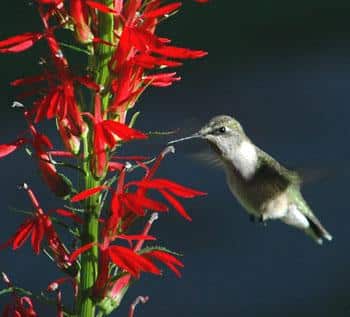Life in the Fast Lane

Ruby-throated hummingbird
Photo credit: Val Cunningham
by Val Cunningham
Contributing Writer
Ruby-throated hummingbirds—among the feistiest birds around—have returned. They winged out of Central America about two weeks before they began appearing in backyards in early May. First to arrive were males, racing to claim a territory and get ready for females, who arrive a couple of weeks later. They battle and squabble with each other and anything else—you, the family dog or other birds—that strays into their feeding territories.
The little nectar sippers settle into some areas before any flowers are in bloom. They survive until bloom time by using an amazing strategy: they sip tree sap, unwittingly provided for them by yellow-bellied sapsuckers.
As the brightly marked woodpeckers chisel their sap wells into tree trunks, hummingbirds follow behind to lap up the liquid, which holds nearly the same sugar concentration as flower nectar. Small insects also are attracted to the sap wells, and hummingbirds lap these up, too, for a protein boost.
A single species
With something like 350 species of hummingbirds in the world, we must be content with just one—the ruby-throat. On the Wing’s contributors hear from people every summer who swear there are several different species of hummingbirds around their feeders. But, except for very rare cases, those “other” hummingbirds are still ruby-throats, albeit green-and-white females or juveniles.
With the fastest metabolism on earth, these little birds must refuel every 15 minutes on average. They’ve been compared to a car with a one-gallon gas tank, requiring many refueling stops.
Most of their daily calorie intake—about 75 percent—comes from flower nectar. When hummingbirds find a source of rich nectar, such as trumpet creeper vine flowers, they visit it frequently during the day.
Web masters
They’re also constantly on alert for protein, in the form of fruit flies, thrips, aphids and spiders—almost any insect small enough to be swallowed. Spiders are an important food item and a source of building supplies. Female hummingbirds pluck the long, nonsticky spider web strands to form her nest. She returns later for some of the sticky webbing to use as “glue” to attach camouflaging material, such as lichen, to the nest’s exterior,
Females handle all the nest-building and chick-rearing duties. They stuff their hatchlings with so many tiny insects and spiders that they’re ready to leave the nest in about three weeks’ time.
In our area, female ruby-throats generally raises two broods during the summer. The minute the first batch is able to fend for itself, she turns around and starts another nest. She often will be incubating eggs and feeding her early twins at the same time.
What can you do to help these hard-working little birds in this busy season? Hang nectar feeders and remember to clean them out every couple days, since sugar water spoils quickly in the heat. Provide a birdbath with a mist attachment, since hummingbirds don’t bathe like other birds but will fly through a mist. And plant things with tiny flowers, since these attract the tiny insects that make up a quarter of their diet.
And when making artificial nectar for hummingbird feeders, please don’t assume more sugar is better: the standard recommendation for 4 parts water to 1 part sugar is the best. A higher concentration of sugar could clog up their little tongues and throats.
St. Paul, Minnesota resident Val Cunningham, leads bird hikes for the St. Paul Audubon Society and writes about nature for local, regional and national newspapers and magazines.



